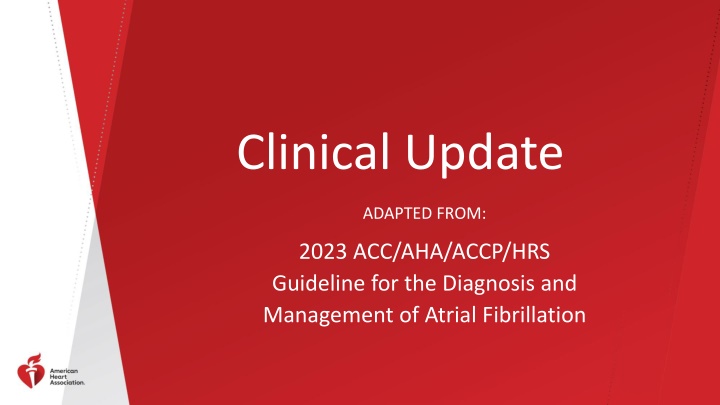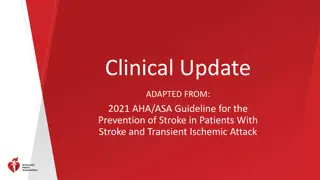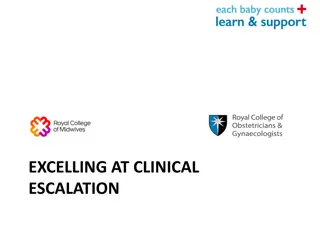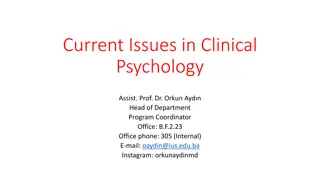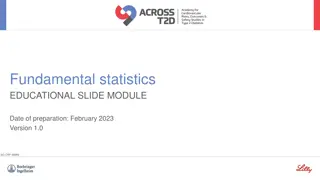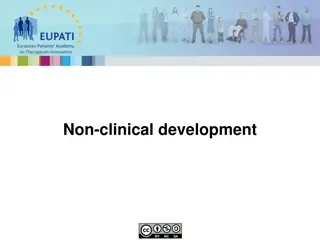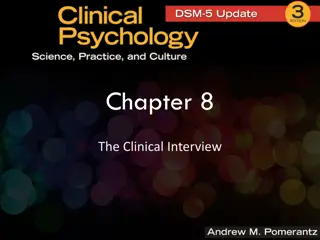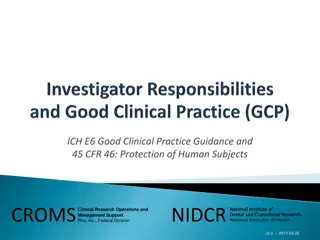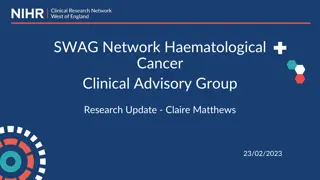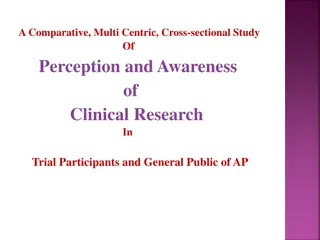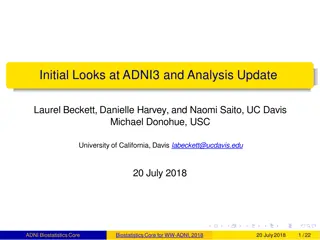Clinical Update
This clinical update presents the 2023 ACC/AHA/ACCP/HRS guideline for diagnosing and managing atrial fibrillation. It categorizes recommendations based on class of recommendation and level of evidence, ranging from strong to weak. Recommendations are supported by high-quality evidence from randomized controlled trials, observational studies, and expert opinions. It emphasizes the balance between benefits and risks in treatment decisions for patients with atrial fibrillation.
Download Presentation

Please find below an Image/Link to download the presentation.
The content on the website is provided AS IS for your information and personal use only. It may not be sold, licensed, or shared on other websites without obtaining consent from the author.If you encounter any issues during the download, it is possible that the publisher has removed the file from their server.
You are allowed to download the files provided on this website for personal or commercial use, subject to the condition that they are used lawfully. All files are the property of their respective owners.
The content on the website is provided AS IS for your information and personal use only. It may not be sold, licensed, or shared on other websites without obtaining consent from the author.
E N D
Presentation Transcript
Clinical Update ADAPTED FROM: 2023 ACC/AHA/ACCP/HRS Guideline for the Diagnosis and Management of Atrial Fibrillation
CLASS (STRENGTH) OF RECOMMENDATION LEVEL (QUALITY) OF EVIDENCE Table 1. Applying Class of Recommendation and Level of Evidence to Clinical Strategies, Interventions, Treatments, or Diagnostic Testing in Patient Care CLASS 1 (STRONG) Benefit >>> Risk LEVEL A High-quality evidence from more than 1 RCT Meta-analyses of high-quality RCTs One or more RCTs corroborated by high-quality registry studies Suggested phrases for writing recommendations: Is recommended Is indicated/useful/effective/beneficial Should be performed/administered/other Comparative-Effectiveness Phrases : Treatment/strategy A is recommended/indicated in preference to treatment B Treatment A should be chosen over treatment B LEVEL B-R (Randomized) Moderate-quality evidence from 1 or more RCTs Meta-analyses of moderate-quality RCTs LEVEL B-NR (Nonrandomized) CLASS 2a (MODERATE) Benefit >> Risk Moderate-quality evidence from 1 or more well-designed, well- executed nonrandomized studies, observational studies, or registry studies Meta-analyses of such studies Suggested phrases for writing recommendations: Is reasonable Can be useful/effective/beneficial Comparative-Effectiveness Phrases : Treatment/strategy A is probably recommended/indicated in preference to treatment B It is reasonable to choose treatment A over treatment B LEVEL C-LD (Limited Data) Randomized or nonrandomized observational or registry studies with limitations of design or execution Meta-analyses of such studies Physiological or mechanistic studies in human subjects CLASS 2b (Weak) Benefit Risk Suggested phrases for writing recommendations: May/might be reasonable May/might be considered Usefulness/effectiveness is unknown/unclear/uncertain or not well- established LEVEL C-EO (Expert Opinion) A recommendation with LOE C does not imply that the recommendation is weak. Many important clinical questions addressed in guidelines do not lend themselves to clinical trials. Although RCTs are unavailable, there may be a very clear clinical consensus that a particular test or therapy is useful or effective. COR and LOE are determined independently (any COR may be paired with any LOE). Consensus of expert opinion based on clinical experience. CLASS 3: No Benefit (MODERATE) Benefit = Risk *The outcome or result of the intervention should be specified (an improved clinical outcome or increased diagnostic accuracy or incremental prognostic information). For comparative-effectiveness recommendation (COR 1 and 2a; LOE A and B only), studies that support the use of comparator verbs should involve direct comparisons of the treatments or strategies being evaluated. Suggested phrases for writing recommendations: Is not recommended Is not indicated/useful/effective/beneficial Should not be performed/administered/other The method of assessing quality is evolving, including the application of standardized, widely-used, and preferably validated evidence grading tools; and for systematic reviews, the incorporation of an Evidence Review Committee. COR indicates Class of Recommendation; EO, expert opinion; LD, limited data; LOE, Level of Evidence; NR, nonrandomized; R, randomized; and RCT, randomized controlled trial. CLASS 3: Harm (STRONG) Risk > Benefit Suggested phrases for writing recommendations: Joglar, J. A. et al., 2023 ACC/AHA/ACCP/HRS Guideline for the Diagnosis and Management of Atrial Fibrillation. Circulation. Joglar, J. A. et al., 2023 ACC/AHA/ACCP/HRS Guideline for the Diagnosis and Management of Atrial Fibrillation. Circulation. Potentially harmful Causes harm Associated with excess morbidity/mortality Should not be performed/administered/other
Prevalence, Incidence, Morbidity and Mortality of AF Prevalence and Incidence of AF is increasing and projected to double between 2010 and 2030 Overall lifetime risk: 30-40% in White individuals 20% in African American individuals 15% in Chinese individuals 50 million estimated individuals with AF worldwide in 2020 AF is associated with increased risks: 1.5-to 2-fold risk of death 2.4-fold risk of stroke 1.5-fold risk of CI/ dementia 1.5-fold risk of MI 2-fold risk of SCD 5-fold risk of HF 1.6-fold risk of CKD 1.3-fold risk of PAD At least 5.6 million individuals with AF in USA in 2015 In Medicare beneficiaries, the most frequent outcome in 5-yrs after AF diagnosis was death (19.5% at 1-yr; 48.8% at 5- yrs) - about 11% estimated cases were undiagnosed AF accounted for $28.4 billion/ year in US healthcare spending in 2016 Abbreviations: AF indicates atrial fibrillation; CI, cognitive impairment; CKD, chronic kidney disease; HF, heart failure; MI, myocardial infarctions; PAD, peripheral arterial disease; SCD, sudden cardiac death; yr, year; and yrs, years. Joglar, J. A. et al., 2023 ACC/AHA/ACCP/HRS Guideline for the Diagnosis and Management of Atrial Fibrillation. Circulation. 3
Risk Factors for Diagnosed Atrial Fibrillation Demographic, Anthropometric, Cardiovascular Risk Factors Advancing Age Smoking Low Physical Activity Elevating Resting Heart Rate Cardiovascular Disease Non-Cardiac Conditions HF CAD Atrial inflammation from pericarditis or myocarditis Cardiac Surgery Valvular Heart Disease Systemic Arterial Hypertension Structural Heart Diseases Obesity Increasing Height Hypertension Diabetes CKD OSA Sepsis Pulmonary disease (COPD, PE) Metabolic disturbances from alcohol abuse, hypokalemia, hyperthyroidism Postoperative state Socioeconomic Determinants of Health Genetic Markers Biological Markers Family history/ heritability GWAS (presence of associated loci) ECG markers (prolonged PR, LVH) Biomarkers (elevated BNP, IL6/TNF-alpha, LP(a)) Imaging markers (increased left atrial size, increased LV wall thickness) Education Level Income Level Socioeconomic status Abbreviations: BNP indicates brain natriuretic peptide; CAD, coronary artery disease; COPD, chronic obstructive pulmonary disease; CKD, chronic kidney disease; GWAS, genome wide association studies; HF, heart failure; IL6, interleukin 6; LP(a), lipoprotein a; LV, left ventricle; LVH, left ventricular hypertrophy; OSA, obstructive sleep apnea; PE, pulmonary embolism; PR, PR interval; and TNF, tumor necrosis factor. Joglar, J. A. et al., 2023 ACC/AHA/ACCP/HRS Guideline for the Diagnosis and Management of Atrial Fibrillation. Circulation. 4
AF Stages: Evolution of Atrial Arrhythmia Progression At Risk for AF Pre-AF AF Permanent AF Patients may transition among different substages of AF Presence of modifiable and nonmodifiable risk factors associated with AF. Evidence of structural or electrical findings further predisposing a patient to AF: Atrial enlargement Frequent atrial ectopy Short bursts of atrial tachycardia Atrial Flutter Other high AF risk scenarios* No further attempts at rhythm control after discussion between patient and clinician Paroxysmal AF (3A) AF that is intermittent and terminates within 7 d of onset Persistent AF (3B) AF that is continuous and sustains for >7d and requires intervention Long-standing persistent AF (3C) AF that is continuous for >12mo in duration Successful AF ablation (3D) No AF identified after percutaneous or surgical intervention to eliminate AF Modifiable risk factors: Obesity Lack of fitness Hypertension Sleep apnea Alcohol Diabetes Nonmodifiable risk factors: Genetics Male sex Age Treat Modifiable Risk Factors Ongoing monitoring as clinically appropriate for AF burden Consider heightened surveillance Is AF associated with pathophysiological changes Stroke risk assessment and therapy if appropriate Treat symptoms Note: *Heart failure, valve disease, coronary artery disease, hypertrophic cardiomyopathy, neuromuscular disorders, thyroid disease. Abbreviations: AF indicates atrial fibrillation, d, day; and mo, month. Joglar, J. A. et al., 2023 ACC/AHA/ACCP/HRS Guideline for the Diagnosis and Management of Atrial Fibrillation. Circulation. 5
Mechanisms and Pathways Leading to AF Abbreviations: AF indicates atrial fibrillation; Ca2+, calcium cation, PACs, premature atrial contractions; and RAAS, renin-angiotensin-aldosterone system. Joglar, J. A. et al., 2023 ACC/AHA/ACCP/HRS Guideline for the Diagnosis and Management of Atrial Fibrillation. Circulation. 6
Contemporary Summary of the Role of the Autonomic Nervous System in AF Abbreviations: AF indicates atrial fibrillation; Ca2+ , calcium cation; HRV, heart rate variability; and LA, left atrium. Joglar, J. A. et al., 2023 ACC/AHA/ACCP/HRS Guideline for the Diagnosis and Management of Atrial Fibrillation. Circulation. 7
Genetics of AF Common and familial AF forms are heritable. Over 100 genetic loci are specific for AF. Rare pathogenic genetic variants in myocardial structural proteins and ion channels may play a role in AF onset at a younger age. TTN loss of function variants are associated with AF. Disease-associated genetic variants in genes with inherited cardiomyopathy or arrhythmias include TTN, MYH7, MYH6, LMNA, and KCNQ1. Disease-associated genetic variants are more prevalent at younger age of AF onset. Abbreviation: AF indicates atrial fibrillation. Joglar, J. A. et al., 2023 ACC/AHA/ACCP/HRS Guideline for the Diagnosis and Management of Atrial Fibrillation. Circulation. 8
Health Inequities and Barriers to AF Management Patients with AF, regardless of sex and gender diversity, race and ethnicity, or adverse SDOH, should be equitably offered guideline-directed stroke risk reduction therapies as well as rate or rhythm control strategies and LRFM as indicated to improve QOL and prevent adverse outcomes. (Class 1) Barriers include: Referral for ablation later in disease course Less likely to be treated with stroke risk reduction therapies More symptomatic and with worse QOL, yet less likely to be referred to EP specialist Less likely to receive catheter ablation Lower oral anticoagulation rates Lower DOAC adherence rates Less use of cardioversion Increased risk of hospitalization, stroke, HF and death Less Educated Low income Inequities in AF care & outcomes UREG Women Abbreviations: AF indicates atrial fibrillation; DOAC, direct oral anticoagulant; EP, electrophysiology; HF, heart failure; LFRM, lifestyle and risk factor modification; QOL, quality of life; SDOH, social determinates of health; and UREG, underrepresented racial and ethnic groups. Joglar, J. A. et al., 2023 ACC/AHA/ACCP/HRS Guideline for the Diagnosis and Management of Atrial Fibrillation. Circulation. 9
Shared Decision Making and Quality of Life in the Management of AF Shared Decision-Making is essential in AF management Publicly Available Decision Aids Agency Website Link Focus Area American College of Cardiology Colorado Program for Patient Centered Decisions https://patientdecisionaid .org/icd/atrial-fibrillation/ Stroke risk reduction therapies Anticoagulation Choice Decision Aid https://anticoagulationde cisionaid.mayoclinic.org/ Stroke risk reduction therapies Decision to anticoagulate Symptom burden and decision to pursue rhythm control AF ablation https:// decisionaid.ohri.ca/AZlist. html Ottawa Hospital Research Institute Developer Healthwise AF ablation Stroke Risk Reduction Stroke risk reduction therapies Stanford https://afibguide.com/ Use of evidence-based decision aids might be useful to guide stroke reduction therapy treatment decisions throughout the disease course to improve engagement, decisional quality and patient satisfaction. (Class 2b) Abbreviation: AF indicates atrial fibrillation. Joglar, J. A. et al., 2023 ACC/AHA/ACCP/HRS Guideline for the Diagnosis and Management of Atrial Fibrillation. Circulation. 10
Rhythm Monitoring Tools and Methods Undiagnosed Atrial fibrillation Known Atrial fibrillation COR RECOMMENDATIONS COR RECOMMENDATIONS Diagnosis should be made with visual interpretation of ECG or intracardiac signals by a clinician. AF frequency, duration and burden can be inferred using automated algorithms from ECG monitors, implantable cardiac monitors, and cardiac rhythm devices with an atrial lead. 1 2a For patients who have had a prior thromboembolic event, implantable cardiac monitors have the highest sensitivity in detecting AF. 2a Consumer-accessible ECG device that provides a high-quality tracing can be used to detect recurrences. 2a Abbreviations: AF indicates atrial fibrillation; and ECG, electrocardiogram. Joglar, J. A. et al., 2023 ACC/AHA/ACCP/HRS Guideline for the Diagnosis and Management of Atrial Fibrillation. Circulation. 11
Primary Prevention of Atrial Fibrillation Hypertension Obesity Diabetes mellitus Lifestyle and Risk Factor Management Physical Activity Smoking Alcohol Consumption Joglar, J. A. et al., 2023 ACC/AHA/ACCP/HRS Guideline for the Diagnosis and Management of Atrial Fibrillation. Circulation. 12
Secondary prevention: Lifestyle Factors COR RECOMMENDATIONS In overweight or obese (BMI > 27 kg/m2) patients, 10% weight loss reduces AF symptoms, burden, recurrence, and progression to persistent AF. 1 Moderate to vigorous exercise training to a target of 210 minutes/week reduces AF symptoms, burden, increases maintenance of SR, increases functional capacity and improves QOL. 1 Cigarette smokers should be advised to quit smoking . They should receive GDMT for tobacco cessation to mitigate risks of adverse CV outcomes. 1 It is reasonable to screen for OSA, given its high prevalence in patients with AF, although the role of tx of sleep disordered breathing to maintain SR is uncertain. 2b Abbreviations: AF indicates atrial fibrillation; BMI, body mass index; CV, cardiovascular; GDMT, guideline-directed medical therapy OSA, obstructive sleep apnea; QOL, quality of life; SR, sinus rhythm; and tx, treatment. Joglar, J. A. et al., 2023 ACC/AHA/ACCP/HRS Guideline for the Diagnosis and Management of Atrial Fibrillation. Circulation. 13
Secondary prevention: Dietary Factors COR RECOMMENDATIONS Patients seeking a rhythm control strategy should minimize or eliminate alcohol consumption to reduce AF recurrence and burden. 1 3: No Caffeine abstention does not prevent AF episodes. It may reduce symptoms in patients who report caffeine triggers. Benefit Abbreviation: AF indicates atrial fibrillation. Joglar, J. A. et al., 2023 ACC/AHA/ACCP/HRS Guideline for the Diagnosis and Management of Atrial Fibrillation. Circulation. 14
Secondary prevention: Medical Conditions COR RECOMMENDATIONS 1 Optimal blood pressure control reduces AF recurrence and AF-related CV events. Comprehensive care addressing LRFM, AF symptoms, risk of stroke, and associated medical conditions reduces AF burden, progression, and consequences. 1 Use of clinical care pathways to promote comprehensive, team-based care enhances adherence to evidence based therapies. 2a Abbreviations: AF indicates atrial fibrillation; CV, cardiovascular; and LRFM, lifestyle and risk factor management. Joglar, J. A. et al., 2023 ACC/AHA/ACCP/HRS Guideline for the Diagnosis and Management of Atrial Fibrillation. Circulation. 15
Risk Stratification Schemes to Prevent Thromboembolic Events in AF COR RECOMMENDATIONS Evaluate for annual risk of thromboembolic events using a validated clinical risk score, such as CHA2DS2-VASc. 1 Key Considerations: Evaluate for factors that indicate a higher risk of bleeding* to identify interventions to prevent bleeding on anticoagulation. 1 The CHA2DS2-VASc score, is considered the most validated score and most therapies have used that score to prove efficacy, thus is generally the preferred score. Those at intermediate annual risk of thromboembolic events (eg, equivalent to CHA2DS2-VASc score of 1 in men or 2 in women), who remain uncertain about the benefit of anticoagulation, can benefit from consideration of factors that might modify their risk of stroke to help inform the decision.** 2a Newer risk scores, such as the ATRIA and GARFIELD-AF scores may be the better option in selected populations (e.g., renal disease). Those deemed at high risk for stroke, bleeding risk scores should not be used in isolation to determine eligibility for oral anticoagulation but instead to identify and modify bleeding risk factors and to inform medical decision-making. 3: No Benefit Note: *Prior bleeding, use of medication that increase bleeding risk **Higher AF burden/Long duration, persistent/permanent AF vs paroxysmal, obesity (BMI, 30 kg/m2), HCM, poorly controlled HTN, eGFR (<45 mL/h), proteinuria (>150 mg/24 h or equivalent), enlarged LA volume ( 73 mL) or diameter ( 4.7 cm) Abbreviations: AF indicates atrial fibrillation; ATRIA, Anticoagulation and Risk Factors in Atrial Fibrillation; BMI, body mass index; CHA2DS2-VASc, congestive heart failure, hypertension, age 75 years (doubled), diabetes mellitus, prior stroke or transient ischemic attack or thromboembolism (doubled), vascular disease, age 65 to 74 years, sex category; cm, centimeter; eGFR, estimated glomerular filtration rate; GARFIELD-AF, Global Anticoagulant Registry in the Field- Atrial Fibrillation; Joglar, J. A. et al., 2023 ACC/AHA/ACCP/HRS Guideline for the Diagnosis and Management of Atrial Fibrillation. Circulation. h, hour; HCM, hypertrophic cardiomyopathy; HTN, hypertension; kg, kilogram; LA, left atrium; m2, meters squared; mg, milligram; mL, millimeter; and vs, versus. 16
Recommendations for Antithrombotic Therapy in AF Annual Risk stratification using CHA2DS2-VASc (Class 1) Intermediate** (~1-2% per yr) High* ( 2% per yr) Low (< 1% per yr) Anticoagulation recommended to prevent stroke and systemic thromboembolism (Class 1) Those without risk factors for stroke, aspirin monotherapy for prevention of thromboembolic events is of no benefit (Class 3: No Benefit) Anticoagulation reasonable to prevent stroke and systemic thromboembolism (Class 2a) If no hx of moderate to severe rheumatic MS or mechanical heart valve and candidate for anticoagulation, DOACs are recommended over warfarin to reduce the risk of mortality, stroke, systemic embolism, and ICH (Class 1) Decisions based on annual stroke risk rather than specific score Candidates for anticoagulation and without an indication for antiplatelet therapy, aspirin either alone or in combination with clopidogrel as an alternative to anticoagulation is not recommended to reduce stroke risk (Class 3: Harm) Note: * CHA2DS2-VASc score of 2 in men and 3 in women ** Equivalent to CHA2DS2-VASc score of 1 in men and 2 in women Reassess risk annually Abbreviations: AF indicates atrial fibrillation; CHA2DS2-VASc, congestive heart failure, hypertension, age 75 years (doubled), diabetes mellitus, prior stroke or transient ischemic attack or thromboembolism (doubled), vascular disease, age 65 to 74 years, sex category; DOACs, direct-acting oral anticoagulants; hx, history; ICH, intracerebral hemorrhage; MS, mitral stenosis; and yr, year. Joglar, J. A. et al., 2023 ACC/AHA/ACCP/HRS Guideline for the Diagnosis and Management of Atrial Fibrillation. Circulation. 17
Oral Anticoagulation for Device-Detected Atrial High-Rate Episodes Among Patients Without a Previous Diagnosis of AF For patients with a device-detected AHRE lasting: COR RECOMMENDATIONS Reasonable (2a) 24 hr 24 hrs and CHA2DS2-VASc score 2 or equivalent stroke risk, it is reasonable to initiate oral anticoagulation within a SDM framework that considers episode duration and individual patient risk. (2a) 2a Reasonable (2b) AHRE Burden Between 5 minutes and 24 hrs and CHA2DS2-VASc score 3 or equivalent stroke risk, it may be reasonable to initiate anticoagulation within a SDM framework that considers episode duration and individual patient risk. (2b) 2b 5 min 3:No Benefit 1 3 4 5 2 6 <5 minutes and without another indication for oral anticoagulation should not receive oral anticoagulation. (3: No Benefit) 3: No Benefit CHA2DS2-VASc Score Abbreviations: AF indicates atrial fibrillation; AHRE, atrial high-rate episode; CHA2DS2-VASc, congestive heart failure, hypertension, age 75 years (doubled), diabetes mellitus, prior stroke or transient ischemic attack or thromboembolism (doubled), vascular disease, age 65 to 74 years, sex category; hr, hour; hrs, hours; and SDM, shared decision-making. Joglar, J. A. et al., 2023 ACC/AHA/ACCP/HRS Guideline for the Diagnosis and Management of Atrial Fibrillation. Circulation. 18
Percutaneous Approaches to Occlude the LAA in AF Patients with Moderate to High Stroke Risk (CHA2DS2-VASc score > 2) In those who have a high risk of major bleeding on oral anticoagulation, pLAAO may be a reasonable alternative to oral anticoagulation based on patient preference, with careful consideration of procedural risk and with the understanding that the evidence for OAC is more extensive. (Class 2b) In those who have a contraindication to long-term OAC due to a nonreversible cause, pLAAO is reasonable. (Class 2a) Long-Term Anticoagulation Is Still Reasonable Long-Term Anticoagulation Contraindicated Bleeding involving the gastrointestinal, pulmonary, or genitourinary systems that is treatable Severe bleeding due to a nonreversible cause involving the gastrointestinal, pulmonary, or genitourinary systems Bleeding related to isolated trauma Spontaneous intracranial/intraspinal bleeding due to a nonreversible cause Bleeding related to procedural complications Serious bleeding related to recurrent falls when cause of falls is not felt to be treatable Abbreviations: AF indicates atrial fibrillation; CHA2DS2-VASc, congestive heart failure, hypertension, age 75 years (doubled), diabetes mellitus, prior stroke or transient ischemic attack or thromboembolism (doubled), vascular disease, age 65 to 74 years, sex category; LAA, left atrial appendage; OAC, oral anticoagulation; and pLAAO, percutaneous left atrial appendage occlusion. Joglar, J. A. et al., 2023 ACC/AHA/ACCP/HRS Guideline for the Diagnosis and Management of Atrial Fibrillation. Circulation. 19
Cardiac Surgery | LAA Exclusion/Excision in AF Patients Evidence supports a benefit of surgical removal of the LAA occlusion in patients with AF who undergo or valve surgeries. In patients with AF undergoing cardiac surgery with a CHA2DS2-VASc score 2 or equivalent stroke risk: In patients with AF undergoing cardiac surgery: COR RECOMMENDATIONS COR RECOMMENDATIONS Surgical LAA exclusion, in addition to continued anticoagulation, is indicated to reduce the risk of stroke and systemic embolism. And LAA exclusion, a surgical technique resulting in absence of flow across the suture line and a stump of <1 cm as determined by intraoperative transesophageal echocardiography should be used. 1 1 The benefit of surgical LAA exclusion in the absence of continued anticoagulation to reduce the risk of stroke and systemic embolism is uncertain. 2b Views of the left atrial appendage before and after surgical exclusion. A, Intact left atrial appendage. B, Resected left atrial appendage before closure. C, Left atrial appendage after sutured amputation. D, Left atrial appendage after stapled excision. E, Left atrial appendage after clip application. Abbreviations: AF indicates atrial fibrillation; CABG, coronary artery bypass graft surgery; CHA2DS2-VASc, congestive heart failure, hypertension, age 75 years (doubled), diabetes mellitus, prior stroke or transient ischemic attack or thromboembolism (doubled), vascular disease, age 65 to 74 years, sex category; cm, centimeter; LAA, left atrial appendage; and TEE, transesophageal echocardiography. Joglar, J. A. et al., 2023 ACC/AHA/ACCP/HRS Guideline for the Diagnosis and Management of Atrial Fibrillation. Circulation. 20
Active Bleeding on Anticoagulant Therapy and Reversal Drugs AGENT REVERSAL RESUMPTION Life-threatening bleed ICH CLASS 1 Non-ICH CLASS 2a Apixaban Reasonable to resume once underlying etiology treated Consider LAAO (2b) Andexanet alfa OR 4F-PCC Edoxaban* Recurrence risk Rivaroxaban PCC Idarucizumab Low High (e.g. CAA) If idarucizumab unavailable Dabigatran Thromboembolism risk 4F-PCC + IV Vitamin K recommended to rapidly achieve INR correction over FFP and IV vitamin K treatment Intermediate/high (< 5%) Very high ( 5%) (e.g. mechanical valve, rheumatic MS) Warfarin Early Delayed Within 1-2 weeks (2a) Within 4-8 weeks (2b) *C-LD LOE applies to data on edoxaban Acute phase Subacute/ Chronic phase Abbreviations: 4F-PCC indicates 4-factor prothrombin complex concentrate; CAA; cerebral amyloid angiopathy; LAAO, left atrial appendage occlusion; ICH, Intracerebral hemorrhage; IV, intravenous; C-LD LOE, Level of evidence C and limited data; MS, mitral stenosis; and PCC, prothrombin complex Joglar, J. A. et al., 2023 ACC/AHA/ACCP/HRS Guideline for the Diagnosis and Management of Atrial Fibrillation. Circulation. concentrate. 21
Timing of Discontinuation of OACs in AF Pts Scheduled to Undergo an Invasive Procedure or Surgery in Whom Anticoagulation is to be Interrupted High Bleeding Risk Procedure Anticoagulant Low Bleeding Risk Procedure Apixaban (CrCl >25 mL/min)* 1 d 2 d Dabigatran (CrCl >50 mL/min) 1 d 2 d Dabigatran (CrCl 30-50 mL/min) 2 d 4 d Edoxaban (CrCl >15 mL/min) 1 d 2 d Rivaroxaban (CrCl >30 mL/min) 1 d 2 d 5 d for a target INR <1.5 2-3 d for a target INR <2 Warfarin 5 d Note: *For patients on DOAC with creatinine clearance lower than the values in the table, few clinical data exist. Consider holding for an additional 1 to 3 days, especially for high bleeding risk procedures. The number of days is the number of full days before the day of surgery in which the patient does not take any dose of anticoagulant. The drug is also not taken the day of surgery. For example, in the case of holding a twice daily drug for 1 day, if the drug is taken at 8 pm, and surgery is at 8 am, at the time of surgery, it will be 36 hours since the last dose was taken. Abbreviations: AF indicates atrial fibrillation; CrCl, creatinine clearance; d, day; DOAC, direct oral anticoagulation; INR, international normalized ratio; and OAC, oral anticoagulant. Joglar, J. A. et al., 2023 ACC/AHA/ACCP/HRS Guideline for the Diagnosis and Management of Atrial Fibrillation. Circulation. 22
Management of Periprocedural Anticoagulation in Patients with AF Patients with AF undergoing invasive procedure or surgery Procedure is a pacemaker or ICD implant Procedure cannot be performed safely on uninterrupted anticoagulation Bridging with LMWH should not be administered (except in patients with mechanical valve or recent stroke or TIA) (3: Harm) CHA2DS2-VASc score 2 or equivalent risk of stroke, on DOAC Temporary cessation or oral anticoagulation without bridging is recommended excluding those with recent stroke or TIA, or a mechanical valve. (1) On Holding Warfarin warfarin, risk of TEs 5% No Resumption of anticoagulation the day after low bleeding risk surgery and between the evening of the second day and the evening of the third day after high bleeding risk surgery. (2a) Yes Timing of interruption of DOAC should be guided by the specific agent, renal function, and the bleeding risk. (1) Either Continued anticoagulation in preference to interruption of warfarin and bridging (1) uninterrupted or interrupted DOAC (2a) Abbreviations: AF indicates atrial fibrillation; CHA2DS2-VASc, congestive heart failure, hypertension, age 75 y (doubled), diabetes mellitus, prior stroke or transient ischemic attack or thromboembolism (doubled), vascular disease, age 65 to 74 y, sex category; DOAC, direct oral anticoagulant; ICD, implantable cardioverter-defibrillator; LMWH, low-molecular-weight heparin; TE, thromboembolism; and TIA, transient Joglar, J. A. et al., 2023 ACC/AHA/ACCP/HRS Guideline for the Diagnosis and Management of Atrial Fibrillation. Circulation. ischemic attack. 23
Anticoagulation in AF Specific Populations ACS or PCI CCD PAD COR RECOMMENDATIONS COR RECOMMENDATIONS COR RECOMMENDATIONS For increased stroke risk in PCI, DOACs preferred over VKAs in combination with APT to reduce risk of clinically relevant bleeding. If beyond 1-y after revascularization or CAD not requiring coronary revascularization, w/o hx of stent thrombosis, OAC monotherapy is recommended over combination therapy of OAC and single APT (aspirin or P2Y12 inhibitor) to decrease risk of major bleeding. With concomitant stable PAD, monotherapy oral anticoagulation is reasonable over dual therapy (anticoagulation plus aspirin or P2Y12 inhibitors) to reduce the risk of bleeding. 1 2a 1 In those on OAC undergoing PCI, early discontinuation of ASA (1-4 wk) and continuation of dual antithrombotic therapy with OAC and a P2Y12 inhibitor is preferred over triple therapy (OAC, P2Y12 inhibitor, and ASA) to reduce risk of clinically relevant bleeding. 1 Abbreviations: ACS indicates acute coronary syndrome; AF, atrial fibrillation; APT, antiplatelet therapy; ASA, aspirin; CAD, coronary artery disease; CCD, chronic coronary disease; DOACs, direct-acting oral anticoagulant; hx, history; OAC, oral anticoagulant; PAD, peripheral artery disease; PCI, percutaneous coronary intervention; VHD, valvular heart disease; VKAs, vitamin K antagonist; and wk, week. Joglar, J. A. et al., 2023 ACC/AHA/ACCP/HRS Guideline for the Diagnosis and Management of Atrial Fibrillation. Circulation. 24
Anticoagulation in AF Specific Populations CKD/Kidney Failure VHD COR RECOMMENDATIONS COR RECOMMENDATIONS If at elevated risk for stroke and CKD stage 3, tx with warfarin or, preferably, evidence-based doses of direct thrombin or factor Xa inhibitors is recommended to reduce stroke risk. In rheumatic mitral stenosis or MS of moderate or greater severity and hx of AF, long-term anticoagulation with warfarin is recommended over DOACs, independent of the CHA2DS2-VASc score to prevent CV events, including stroke or death. 1 1 If at elevated risk for stroke and CKD stage 4, tx with warfarin or labeled doses of DOACs is reasonable to reduce stroke risk. 2a In valve disease other than moderate or greater mitral stenosis or a mechanical heart valve, DOACs are recommended over VKAs. 1 If at elevated risk for stroke & end-stage CKD (CrCl <15 mL/min) or on dialysis, it might be reasonable to prescribe warfarin (INR 2.0-3.0) or an evidence-based dose apixaban for oral anticoagulation to reduce stroke risk. 2b Abbreviations: AF indicates atrial fibrillation; CHA2DS2-VASc, congestive heart failure, hypertension, age 75 years (doubled), diabetes mellitus, prior stroke or transient ischemic attack or thromboembolism (doubled), vascular disease, age 65 to 74 years, sex category; CKD, chronic kidney disease; CrCl, creatinine clearance; CV, cardiovascular; DOACs, direct-acting oral anticoagulant; hx, history; INR, international normalized ratio; min, minute; ml, milliliter; MS, mitral stenosis; tx, treatment; VHD, valvular heart disease; and VKAs, vitamin K antagonists. Joglar, J. A. et al., 2023 ACC/AHA/ACCP/HRS Guideline for the Diagnosis and Management of Atrial Fibrillation. Circulation. 25
Treatment: Rate Control in AF Objectives of Rate Control: Comorbidities Resting heart rate < 100-110 bpm Reduce symptoms Shared decision making & Reduce risk of tachycardia-induced cardiomyopathy or improve heart function of patients with tachycardia-induced cardiomyopathy Different factors that guide decision of Rate vs Rhythm therapy Clinical presentation patient preference Reduce inappropriate shock in patients with implantable defibrillators Enhance biventricular pacing in patients with cardiac resynchronization therapy use Presence of Heart Failure Medication Profile Reduce risk of hospitalization Abbreviations: AF indicates atrial fibrillation; bpm, beats per minute; and vs, versus. Joglar, J. A. et al., 2023 ACC/AHA/ACCP/HRS Guideline for the Diagnosis and Management of Atrial Fibrillation. Circulation. 26
Pharmacological Agents for Rate Control in AF Rate Control Agents Oral Beta- Blocker Oral Maintenance dose Non-DHP CCB IV IV Maintenance dose 2.5-5 mg bolus over 2 mins; up to 3 doses Beta-Blockers Slows AV nodal conduction Block B-1 receptors Metoprolol tartrate 25 200 mg twice daily 0.25 mg/kg IV over 2 mins. May repeat 0.35 mg/kg over 2 mins; then 5-15 mg/hr continuous infusion 5 to 10 mg over 2 minutes (may repeat twice); then 5 mg/hr continuous infusion (max 20 mg/hr) IV 120 360 mg daily (ER) Metoprolol succinate Diltiazem 50 - 400 mg daily N/A Digoxin Positive inotropic and vagotonic effects Could be useful in HFrEF pts Atenolol 25 100 mg daily N/A 180 480 mg daily (ER) Oral Maintenance dose Verapamil IV Magnesium Blocks slow inward calcium channels of SA and AV node Bisoprolol 2.5 10 mg daily N/A Agent 3.125- 25 mg twice daily Carvedilol N/A Amiodarone Useful in critical ill pts who cannot tolerate AV nodal slowing agents Can result in pharmacologic cardioversion 150-300 mg IV over 1 hr, then 10-50 mg/h over 24 hrs 500 mcg/kg bolus over 1 min; then 50 300 mcg/kg/min Amiodarone 100 200 mg daily Esmolol N/A Digoxin* 0.25 0.5 mg over mins; repeat doses of 0.25 mg every 6 hrs (max 1.5 mg/24 hrs) Nadolol 10-240 mg daily N/A NDCC Slow AV nodal conduction Negative inotropic and chronotropic effect 0.0625 0.25 mg daily *Increased mortality at plasma concentrations exceeding 1.2 ng/mL 1 mg over 1 min; repeat PRN every 2 mins; up to 3 doses 10-40 mg three to four times daily Propranolol Abbreviations: AF indicates atrial fibrillation; AV, atrioventricular; ER, extended release; HFrEF, heart failure with reduced ejection fraction; hr, hour; hrs, hours; IV, intravenous; kg, kilogram; min; minute; mins, minutes; mg, milligram; mcg, microgram; ng, nanogram; NDCC, nondihydropyridine calcium channel blocker; PRN, as needed; pts, patients; and SA, sinoatrial. Joglar, J. A. et al., 2023 ACC/AHA/ACCP/HRS Guideline for the Diagnosis and Management of Atrial Fibrillation. Circulation. 27
Approach to Acute Rate Control in AF with Rapid Ventricular Response Hemodynamically Stable? Yes No Direct-Current Cardioversion (1) Decompensated HF? Yes No BB, verapamil, or diltiazem (1) IV Amiodarone* (2b) Addition of Magnesium to AV nodal blockage (2a) Verapamil, diltiazem (3: Harm) Digoxin (2a) Amiodarone (2b) *Contraindicated in patients with moderate-severe LV dysfunction regardless of decompensated HF. Abbreviations: AF indicates atrial fibrillation; AV, atrioventricular; BB, beta-blocker; HF, heart failure; IV, intravenous; and LV, left ventricular. Joglar, J. A. et al., 2023 ACC/AHA/ACCP/HRS Guideline for the Diagnosis and Management of Atrial Fibrillation. Circulation. 28
Approach to Long Term Rate Control of AF Long-term rate control Permanent AF Dronedarone (3: Harm) LVEF 40% LVEF >40% BB (1) BB or NDCC (1) NDCC (Diltiazem, Verapamil) (3: Harm) Digoxin (2a) Digoxin (2a) Abbreviations: AF indicates atrial fibrillation; BB, beta-blocker; LVEF, left ventricular ejection fraction; and NDCC, nondihydropyridine calcium channel blocker. Joglar, J. A. et al., 2023 ACC/AHA/ACCP/HRS Guideline for the Diagnosis and Management of Atrial Fibrillation. Circulation. 29
Recommendations for Atrioventricular Nodal Ablation COR RECOMMENDATIONS In patients with AF and a persistently rapid ventricular repose who undergo AVNA, initial pacemaker lower rate programming should be 80 to 90 bpm to reduce the risk of sudden death. 1 In patients with AF and uncontrolled rapid ventricular response refractory to rate-control medications, AVNA can be useful to improve symptoms and QOL. 2b In patients with AF scheduled to have an AVNA, implantation of a pacemaker prior to procedure is recommended to ensure adequacy of the pacing leads before performing the ablation. 1 In patients with AF and normal EF undergoing AVNA, conduction system pacing of the His bundle or left bundle area may be reasonable. 2b Abbreviations: AF indicates atrial fibrillation; AVNA, atrioventricular nodal ablation; bpm, beats per minute; EF, ejection fraction; and QOL, quality of life. Joglar, J. A. et al., 2023 ACC/AHA/ACCP/HRS Guideline for the Diagnosis and Management of Atrial Fibrillation. Circulation. 30
Goals of Rhythm Control Therapy in AF Rhythm control in patients with Reduced LV function & Persistent AF Recent AF Diagnosis (< 1 year) AF and HF Symptomatic AF Rhythm control can be useful to improve symptoms (2a) Rhythm control can be useful to reduce hospitalizations, stroke, and mortality (2a) A trial of rhythm control recommended to evaluate if AF is contributing to reduced LV function (1) Rhythm control can be useful for improving symptoms and outcomes such as mortality and hospitalizations for HF and ischemia (2a) In patients with AF, rhythm-control strategies can be useful to reduce the likelihood of AF progression.(2a) In patients with AF where symptoms associated with AF are uncertain, a trial of rhythm control (eg, cardioversion or pharmacological therapy) may be useful to determine what if any symptoms are attributable to AF (2b) In patients with AF, rhythm-control strategies may be useful to reduce the likelihood of development of dementia or worsening cardiac structural abnormalities.(2b) Abbreviations: AF indicates atrial fibrillation; HF, heart failure; and LV, left ventricular. Joglar, J. A. et al., 2023 ACC/AHA/ACCP/HRS Guideline for the Diagnosis and Management of Atrial Fibrillation. Circulation. 31
Electrical and Pharmacological Cardioversion of AF Hemodynamically Stable? Yes No Electrical cardioversion can be performed as initial rhythm-control strategy or after unsuccessful pharmacological cardioversion. (1) Immediate electrical cardioversion should be performed (1) Or in situations when electrical cardioversion is preferred but cannot be performed. (2a) Recommendations for pharmacologic cardioversion Recommendations for electrical cardioversion COR RECOMMENDATIONS COR RECOMMENDATIONS Ibutilide is reasonable for pharmacological cardioversion for pts w/o depressed LV function (LVEF <40%). (1) Electrical cardioversion, energy delivery should be confirmed to be synchronized to the QRS to reduce the risk of inducing VF. (1) 2a 1 IV amiodarone is reasonable for pharmacological cardioversion, although time to conversion is generally longer than other agents (8-12 hours). (2a) In elective electrical cardioversion, the use of biphasic energy of at least 200 J as initial energy can be beneficial to improve success of initial electrical shock. (2a) 2a 2a Recurrent AF occurring outside the hospital, the PITP approach with a single oral dose of flecainide or propafenone, with concomitant AV nodal blocking agent,15 is reasonable for pharmacological cardioversion if previously tested in a monitored setting. (2a) In pts undergoing elective cardioversion, with longer duration of AF or unsuccessful initial shock, optimization of electrode vector, use of higher energy, and pretreatment with antiarrhythmic drugs can facilitate success of electrical cardioversion. (2a) 2a 2a In pts with obesity and AF, use of manual pressure augmentation and/or further escalation of electrical energy may be beneficial to improve success of electrical cardioversion. (2b) Use of IV procainamide may be considered for pharmacological cardioversion when other intravenous agents are contraindicated or not preferred. (2b) Abbreviations: AF indicates atrial fibrillation; AV, atrioventricular; IV, intravenous; LV, left ventricular; LVEF, left ventricular ejection fraction; pts, patients; PTTP, pill-in-the-pocket; QRS, QRS interval; and VF, ventricular fibrillation. 2b 2b Joglar, J. A. et al., 2023 ACC/AHA/ACCP/HRS Guideline for the Diagnosis and Management of Atrial Fibrillation. Circulation. 32
Antiarrhythmic Drugs for Maintenance of Sinus Rhythm Atrial fibrillation Normal LV function, no prior MI or significant structural heart disease Considerations: Prior MI or significant structural heart disease, including HFrEF (LVEF 40%) Risk of development of MI and structural heart disease NYHA FC III or IV or recent decompensated Hf Amiodarone Dofetilide (2a) Dofetilide Dronedarone Flecainide Propafenone (2a) The need for in-hospital initiation of antiarrhythmic drugs Yes No Baseline and follow-up tests Dronedarone (2a) Dronedarone (3: Harm) Sotalol (2b) Amiodarone (2a) Flecainide Propafenone (3: Harm) Sotalol (2b) Abbreviations: HF indicates heart failure; HFrEF, heart failure reduced ejection fraction; LV, left ventricle; LVEF, left ventricular ejection fraction; MI, myocardial infarction; and NYHA FC, New York Heart Association Functional Class. Joglar, J. A. et al., 2023 ACC/AHA/ACCP/HRS Guideline for the Diagnosis and Management of Atrial Fibrillation. Circulation. 33
Antiarrhythmic Drug Initiation in Facility DURATION OF IN-FACILITY OBSERVATION COR MEDICATION FACILITY SHOULD BE CAPABLE OF: Continuous ECG monitoring Periodic CrCl Cardiac resuscitation 1 Dofetilide (1) Admission for 3 days Continuous ECG monitoring Periodic creatinine clearance calculations Cardiac resuscitation 2a Sotalol (2a) 3 days Flecainide and Propafenone as PTTP (2a) 2a First dose in a facility Continuous EG monitoring Abbreviations: CrCl indicates creatinine clearance; ECG, electrocardiogram; and PTTP, pill-in-the-pocket. Joglar, J. A. et al., 2023 ACC/AHA/ACCP/HRS Guideline for the Diagnosis and Management of Atrial Fibrillation. Circulation. 34
Antiarrhythmic Drug Follow-up BASELINE WITHIN 6 MONTHS EVERY 3-6 MONTHS AFTER ECG K and Mg CrCl ECG K and Mg CrCl ECG K and Mg CrCl Dofetilide ECG AST and ALT -- Dronedarone AST and ALT ECG K and Mg Continuous ECG at least 4 hours following infusion -- Ibutilide ECG BP ECG BP during infusion -- Procainamide ECG K and Mg CrCl ECG K and Mg CrCl ECG K and Mg CrCl Sotalol TSH AST, ALT TSH AST, ALT CXR ECG TSH AST, ALT Amiodarone If symptoms -> Assess for ILD, epithelial keratopathy Annual dermatologic and neurologic exam Abbreviations: ALT indicates alanine transaminase; AST, aspartate aminotransferase; BP, blood pressure; CrCl, creatinine clearance; CXR, chest x-ray; ECG, electrocardiogram; ILD, interstitial lung disease; K, potassium; Mg, magnesium; and TSH, thyroid stimulating hormone. Joglar, J. A. et al., 2023 ACC/AHA/ACCP/HRS Guideline for the Diagnosis and Management of Atrial Fibrillation. Circulation. 35
Anticoagulation Management Strategy Before & After AF Ablation Prior to ablation After ablation COR RECOMMENDATIONS COR RECOMMENDATIONS Catheter ablation should be performed on uninterrupted therapeutic anticoagulation with a goal INR of 2.0 to 3.0. OAC should be continued for at least 2 to 3 months after the procedure with a longer duration determined by underlying risk. 1 1 If patient on a DOAC, catheter ablation should be performed with either continuous or minimally interrupted oral anticoagulation. Continuation of longer-term OAC should be dictated according to the patients stroke risk (eg, CHA2DS2-VASc score 2). 1 1 Abbreviations: AF indicates atrial fibrillation; CHA2DS2-VASc, congestive heart failure, hypertension, age 75 years (doubled), diabetes mellitus, prior stroke or transient ischemic attack or thromboembolism (doubled), vascular disease, age 65 to 74 years, sex category; DOAC, direct oral anticoagulant; INR, international normalized ratio; and OAC, oral anticoagulant. Joglar, J. A. et al., 2023 ACC/AHA/ACCP/HRS Guideline for the Diagnosis and Management of Atrial Fibrillation. Circulation. 36
AF Management in Patients with HF GDMT, Thromboembolism prophylaxis, Risk factor modification Cardioversion if indicated Rate Control LVEF> 40% Electrical Cardioversion (1) LVEF< 40% Pharmacological Cardioversion (2a) Beta-Blockers or NDCC (1) NDCC (Diltiazem, Verapamil) (3:Harm) Beta-Blockers (1) Digoxin (2a) Digoxin (2a) IV Amiodarone Acute rate control (2a) IV Amiodarone Acute rate control (2a) Evaluate if appropriate for rhythm control with catheter ablation see next slide Abbreviations: AF indicates atrial fibrillation; HF, heart failure; IV, intravenous; and NDCC, non-dihydropyridine calcium channel blockers. Joglar, J. A. et al., 2023 ACC/AHA/ACCP/HRS Guideline for the Diagnosis and Management of Atrial Fibrillation. Circulation. 37
AF Management in Patients with HF Evaluate if appropriate for rhythm control with catheter ablation see previous slide Likely to benefit from catheter ablation AF-mediated CMP suspected Early stage of HF No significant ventricular scar on CMR No or mild atrial fibrosis Paroxysmal and early persistent AF Younger pts w/o significant other comorbidities Less Likely to benefit from catheter ablation Advanced HF Significant ventricular scar on CMR Severe atrial myopathy (dilation/fibrosis) Long-standing persistent AF Prior failed ablations Advanced age or multiple comorbidities HFrEF (LVEF<50%) Uncontrolled rate + rhythm control failed or not appropriate: AV nodal ablation + pacing (2a) Left bundle of His bundle pacing as alternative to biventricular pacing (2b) HFrEF HFpEF Decision for pharmacological rhythm vs rate-control strategy AF catheter ablation (1) AF catheter ablation (2a) Uncontrolled rate with biventricular pacemaker in place without effective pacing %: AV Nodal ablation (2a) Pharmacological cardioversion and maintenance of SR after cardioversion No clinical AF Recurrent AF Dronedarone NYHA Class III/IV HF or decompensated HF in past 4 wk (3:Harm) Repeat ablation Long-term surveillance for recurrent AF (in AF-induced CMP and recovered LVEF (2a) Abbreviations: AF indicates atrial fibrillation; AV, atrioventricular; CMP, cardiomyopathy; CMR, cardiac magnetic resonance; GDMT, guideline-directed medical therapy; HF, heart failure; HFpEF, heart failure with preserved ejection fraction; HFrEF, heart failure with reduced ejection fraction; IV, intravenous; LVEF, left ventricular ejection fraction; NYHA, New York Heart Association; and wk, week. Joglar, J. A. et al., 2023 ACC/AHA/ACCP/HRS Guideline for the Diagnosis and Management of Atrial Fibrillation. Circulation. 38
Management of Early Onset AF, Athletes, Obesity, Hyperthyroidism, Pulmonary disease Obesity (Class III) Age Athletes Hyperthyroidism Pulmonary Disease BMI 40 kg/m2 Bariatric surgery PH with Pulmonary Vascular Disease <45 yr <30 yr COPD Rhythm control- catheter ablation with PV isolation is reasonable (2a) Anticoagulation until euthyroid and SR maintained (1) The following may be reasonable: EP study to evaluate and treat reentrant SVT (2b) DOACs reasonable over warfarin (2a) Warfarin may be reasonable over DOACs due to DOAC drug absorption concerns (Class 2b) Rate control- Cardio-selective beta-blockers especially in MI and HF (2a) Rhythm control- strategy is reasonable (2a) Referral for genetic counseling Genetic testing for rare pathogenic variants Targeted ablation may be reasonable (2b) Surveillance for cardiomyopathy or arrhythmia syndromes (2b) Abbreviations: AF indicates atrial fibrillation; COPD, chronic obstructive pulmonary disease; DOACs, direct-acting oral anticoagulants; EP, electrophysiologic; HF, heart failure; HTN, hypertension; kg/m2, kilogram per meters squared; MI, myocardial ischemia; PH, pulmonary hypertension; PV, pulmonary vein; SR, sinus rhythm; and SVT, supraventricular tachyarrhythmias. Joglar, J. A. et al., 2023 ACC/AHA/ACCP/HRS Guideline for the Diagnosis and Management of Atrial Fibrillation. Circulation. 39
Management of AF in Cardio-Oncology, Liver disease, and CKD CKD/Kidney Failure at Elevate Stroke Risk Mild or Moderate Liver Disease (Child-Pugh Class A or B) Cardio-Oncology OACs in the absence of clinically significant liver disease-induced coagulopathy or thrombocytopenia (2a) Cancer and AF Cancer with risk for AF ESRD/ Dialysis CKD Stage 3 CKD Stage 4 Multidisciplinary communication & SDM (Reduce drug interactions; QTc prolongation; proarrhythmia; bleeding; and thromboembolism) (1) DOACs preferred over VKAs for stroke risk reduction (2a) It might be reasonable to prescribe warfarin (INR 2-3) OR Apixaban evidence-based dose (2b) Increased vigilance for incident AF and treatment of contributing factors (2a) Evidence based doses of direct thrombin or factor Xa inhibitors OR Warfarin (1) Warfarin OR labelled doses of DOACs (2a) Class B: Apixaban, Dabigatran, or Edoxaban preferred over warfarin (2a) Class A: Any DOAC (2a) Patients with AF and moderate liver disease (Class B): Rivaroxaban is contraindicated due to increased risk of bleeding (3:Harm) Abbreviations: AF indicates atrial fibrillation; CKD, chronic kidney disease; DOACs, direct-acting oral anticoagulants; ESRD, end stage renal disease; INR, international normalised ratio OACs, oral anticoagulants; QTc, QT interval corrected for heart rate; SDM, shared decision- making; and VKAs, vitamin K antagonists. Joglar, J. A. et al., 2023 ACC/AHA/ACCP/HRS Guideline for the Diagnosis and Management of Atrial Fibrillation. Circulation. 40
Pregnancy and the AF Patient Pregnancy with AF Direct-current cardioversion (1) No Structural heart disease Elevated stroke risk Persistent AF Stable AF SDM regarding anticoagulation with the recognition that no anticoagulation strategy is completely safe for both the mother and fetus (2b) Rate control: Beta blocker (propranolol/metoprolol ) & digoxin either alone or in combination with beta blocker are reasonable as first-line agents (2a) Pharmacologic cardioversion: IV Procainamide may be considered (2b) Rhythm control: Flecainide, Sotalol are reasonable (2a) Abbreviations: AF indicates atrial fibrillation; IV, intravenous; and SDM, shared decision-making. Joglar, J. A. et al., 2023 ACC/AHA/ACCP/HRS Guideline for the Diagnosis and Management of Atrial Fibrillation. Circulation. 41
Prevention and Treatment of AF After Cardiac Surgery Treatment of AF After Cardiac Surgery Rate control: Beta-blocker OR CCB (1) Prevention of AF After Cardiac Surgery Consider anticoagulation when deemed safe from surgical bleeding (2a) Hemodynamically unstable or poorly tolerated AF CABG, aortic valve, ascending aortic aneurysm operations: posterior left pericardiotomy (2a) Patients at high risk for postop AF: Short-term prophylactic beta- blockers or amiodarone (2a) Hemodynamically stable Direct current cardioversion with antiarrhythmic drug therapy (1) Rhythm control (1) Rate control (target HR <100 bpm) with beta- blocker or CCB (1) 30 to 60-day postop rhythm assessment cardioversion if AF does not revert to SR (2a) Abbreviations: AF indicates atrial fibrillation; bpm, beats per minute; CABG, coronary artery bypass graft surgery; CCB, calcium channel blocker; HR, heart rate; pts, patients; and SR, sinus rhythm. Joglar, J. A. et al., 2023 ACC/AHA/ACCP/HRS Guideline for the Diagnosis and Management of Atrial Fibrillation. Circulation. 42
Wolff-Parkinson-White and Pre-Excitation syndromes, ACHD, and HCM AF with rapid anterograde conduction (pre-excited AF) ACHD and AF HCM and AF DOACs are first line in pts with clinical or subclinical AF (duration > 24 hours) (1) If hemodynamically unstable, should be treated with electrical cardioversion (1) Catheter ablation of accessory pathways is recommended (1) Evaluate and treat precipitating/reversible causes (1) VKAs are second line independent of CHA2DS2-VASc score (1) Rhythm control: If symptomatic/ paroxysmal/ persistent AF (1) Rate control: beta blocker/ verapamil/ diltiazem (1) If undergoing PVI, may be reasonable to include ablative strategy in the right atrium (2b) If AF is poorly tolerated, rhythm control strategy with cardioversion or anti-arrhythmic drugs can be beneficial (2a) If hemodynamically stable, pharmacological cardioversion with intravenous ibutilide or IV procainamide is recommended as an alternative to elective cardioversion (1) Moderate or Complex/Severe ACHD Simple CHD Catheter ablation can be effective if drug therapy is ineffective, contraindicated or not patient preference (2a) EP procedures in collaboration with ACHD cardiologist at specialized centers (1) Anticoagulation in pts with low-flow states: Fontan circulation, blind-ending cardiac chambers & cyanosis (2b) Ablation: If symptomatic and antiarrhythmic drug refractory (2a) Do not use AV Nodal blocking agents: Verapamil, Diltiazem, Amiodarone, Digoxin, Adenosine, or Beta-blockers (3:Harm) In pts undergoing surgical myectomy, surgical AF ablation can be beneficial (2a) Abbreviations: ACHD indicates adult congenital heart disease; AF, atrial fibrillation; AV, atrioventricular; CHA2DS2-VASc, congestive heart failure, hypertension, age 75 years (doubled), diabetes mellitus, prior stroke or transient ischemic attack or thromboembolism (doubled), vascular disease, age 65 to 74 years, sex category; CHD, congenital heart disease; DOACs, direct-acting oral anticoagulants; EP, electrophysiologic; HCM, hypertrophic cardiomyopathy; IV, intravenous; pts, patients; PVI, pulmonary vein isolation; VKA, vitamin K antagonists; and WPW, Wolff-Parkinson-White. Joglar, J. A. et al., 2023 ACC/AHA/ACCP/HRS Guideline for the Diagnosis and Management of Atrial Fibrillation. Circulation. 43
AF in the setting of Acute Medical Illness or Surgery AF in acute medical illness or surgery Outpatient follow-up: Thromboembolic risk stratification and decision making on OAC initiation/ continuation AF surveillance (Class 2a) Counseling regarding risk of recurrent AF (Class 1) Anticoagulation in the setting of sepsis: uncertain benefits (Class 2b) Abbreviations: AF indicates atrial fibrillation and OAC, oral anticoagulation. Joglar, J. A. et al., 2023 ACC/AHA/ACCP/HRS Guideline for the Diagnosis and Management of Atrial Fibrillation. Circulation. 44
Future Research Needs Evaluation of the AF Patient: Management of the AF Patient: AF as a disease continuum Wearable heart monitoring devices Individualization of AF and stroke risk Strategies for anticoagulation Downstream consequences of AF Race, gender and sex differences Standardization of ablation procedures Incorporating other stroke risk scores Surgical exclusion and occlusion of LAA Standardized measures Candidates for ablation Social determinants of health Role of risk modifiers in AF stroke prevention Genetic testing Shared decision making Subclinical AF AI for AF management Sleep Better goal and outcome definition Abbreviations: AF indicates atrial fibrillation; AI, artificial intelligence; and LAA, left atrial appendage. Joglar, J. A. et al., 2023 ACC/AHA/ACCP/HRS Guideline for the Diagnosis and Management of Atrial Fibrillation. Circulation. 45
Acknowledgments Many thanks to our Guideline Ambassadors who were guided by Dr. Elliott Antman in developing this translational learning product in support of the Joglar, J. A. et al., 2023 ACC/AHA/ACCP/HRS Guideline for the Diagnosis and Management of Atrial Fibrillation. Dr. Henrietta Afari Dr. Pradnya Brijmohan Bhattad Dr. Balaram Krishna Hanumanthu Dr. Evan Harmon Dr. Mary-Jo Obeid Dr. Justice Oranefo Dr. Iqra Qamar Dr. Ozan Unku The American Heart Association requests this electronic slide deck be cited as follows: Afari, H., Bhattad, P.B., Hanumanthu, B.K., Harmon, E., Obeid, M., Onanefo, J., Qamar, I., Unku, O., Reyna, G., Bezanson, J. L., & Antman, E. M. (2023). AHA Clinical Update; Adapted from: [PowerPoint slides]. Retrieved from the 2023 ACC/AHA/ACCP/HRS Guideline for the Diagnosis and Management of Atrial Fibrillation. Circulation. https://professional.heart.org/en/science-news. Joglar, J. A. et al., 2023 ACC/AHA/ACCP/HRS Guideline for the Diagnosis and Management of Atrial Fibrillation. Circulation. 46
